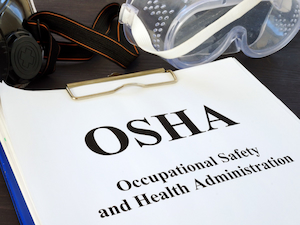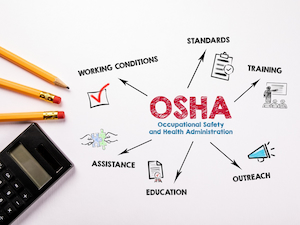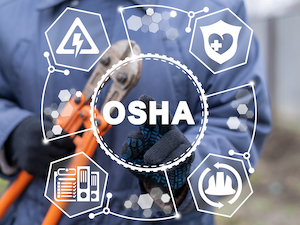A common question from small business owners is whether they are exempt from OSHA regulations if they have fewer than 10 employees. Some assume that being a small company means they don’t have to follow OSHA standards or maintain a safety program. The reality is more complex.

Let’s clear up the confusion about who is exempt from OSHA, what small businesses are required to do, and why a safety program is still essential, even for companies with just a handful of employees.
Which Types of Companies are Exempt from OSHA?
There are only a few situations where OSHA does not have jurisdiction in the United States and these include:
- Self-employed individuals with no employees
- Family farms where only immediate family members are employed
- Workplaces regulated by other federal agencies, such as mines (MSHA) or certain transportation sectors
- Public sector employees in states without their own OSHA-approved state plan
To clarify the last point, for example, public employees in Texas aren’t covered because Texas has no state OSHA plan, while public employees in California are covered under Cal/OSHA.
If your business doesn’t fit into one of these categories, OSHA still applies, even if you consider your company a small business.

What About Businesses With Fewer Than 10 Employees?
Having fewer than 10 employees does not mean you are exempt from OSHA. However, it does give you a partial exemption from certain requirements:
- You are not required to maintain OSHA injury and illness recordkeeping forms, unless specifically asked by OSHA or the Bureau of Labor Statistics.
- If your business is classified as low-hazard and has 10 or fewer employees, OSHA will not conduct routine programmed inspections. However, inspections can still happen if there’s a complaint, a serious incident, or an imminent danger.
OSHA Standard 1904.1(a)(1) If your company had 10 or fewer employees at all times during the last calendar year, you do not need to keep OSHA injury and illness records unless OSHA or the Bureau of Labor Statistics informs you in writing that you must keep records. All employers covered by the OSH Act must report to OSHA any work-related incident that results in a fatality, the in-patient hospitalization of one or more employees, an employee amputation, or an employee loss of an eye. (link)
Even if your business is low‑hazard and has fewer than 10 employees, it is still covered under the OSH Act. You must comply with OSHA standards, but you are exempt from routine inspections and most recordkeeping requirements. But you are still required to:
- Maintain a safe workplace free of known hazards.
- Follow applicable OSHA standards, which may cover workplace safety areas such as fire prevention, personal protective equipment, hazard communication, machine safety, or emergency procedures.
- Train employees on safety procedures and protective equipment.
- Report serious incidents, including fatalities, hospitalizations, amputations, and the loss of an eye.
- Be prepared for inspections if there's a complaint or an imminent danger situation.
So while the paperwork burden is lighter for businesses with fewer than 10 employees, the responsibility for worker safety remains the same.

Does OSHA Conduct Inspections on Small, Low‑Hazard Businesses?
Small businesses in low‑hazard industries with 10 or fewer employees are generally exempt from programmed OSHA inspections, meaning OSHA won’t routinely schedule safety inspections for these workplaces.
However, this does not mean OSHA cannot inspect or enforce standards. Exceptions still apply. OSHA could inspect if:
- An employee files a safety or health complaint
- A fatality occurs
- Two or more employees are hospitalized from a workplace incident
- An imminent danger is reported or observed
These exceptions are outlined in OSHA’s Enforcement Exemptions and Limitations under the Appropriations Act (see OSHA.gov).
So even with this limited inspection exemption, employers must still follow all applicable OSHA standards and maintain a safe workplace.

Do Small Businesses Need a Written Safety Program?
Being a small business with fewer than 10 employees does not exempt you from OSHA. It only reduces certain recordkeeping and inspection requirements. You still must provide a safe workplace, train employees, and report serious incidents.
Even if your business is small or considered low-risk, a written safety program is an important tool. Here’s why:
- It ensures compliance. OSHA standards still apply to your workplace, and having documented policies makes it easier to show you’re meeting requirements.
- It protects employees. A written safety program clearly outlines how to recognize and avoid hazards, keeping your team safe.
- It reduces liability. Written policies demonstrate a good-faith effort to maintain a safe workplace, which can help in the event of an incident.
- It prepares you for inspections. If OSHA visits your site after a complaint or accident, having a documented safety program shows you’re proactive about safety.
- It improves safety culture. A clear set of guidelines helps employees take safety seriously, even in a small business setting.
While a written safety program may not be legally required for every small business, having one is highly recommended. It helps document your commitment to safety, clarify procedures for employees, and prepare you for inspections.
Even the smallest businesses benefit from having a written plan that outlines safety procedures, emergency actions, and training requirements.
Certain OSHA standards, like hazard communication, emergency action plans, or confined spaces, do require written documentation if they apply to your workplace, even for small businesses.
If you’re unsure where to start, OSHA offers free resources on their Helping Small Businesses website (OSHA.gov) where they provide further guidance on employer responsibilities, safety and health programs, and compliance.
Ongoing safety training is essential for keeping employees informed and engaged. Free workplace safety meeting videos are available on YouTube to help reinforce important topics and support a strong safety culture.

.jpg)

.jpg)